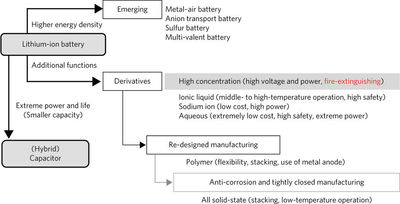PRESS RELEASE
- Research
- 2017
Fire-extinguishing organic electrolytes for safe batteries
Authors
Jianhui Wang, Yuki Yamada, Keitaro Sodeyama, Eriko Watanabe, Koji Takada, Yoshitaka Tateyama & Atsuo Yamada
Abstract
Severe safety concerns are impeding the large-scale employment of lithium/sodium batteries. Conventional electrolytes are highly flammable and volatile, which may cause catastrophic fires or explosions. Efforts to introduce flame-retardant solvents into the electrolytes have generally resulted in compromised battery performance because those solvents do not suitably passivate carbonaceous anodes. Here we report a salt-concentrated electrolyte design to resolve this dilemma via the spontaneous formation of a robust inorganic passivation film on the anode. We demonstrate that a concentrated electrolyte using a salt and a popular flame-retardant solvent (trimethyl phosphate), without any additives or soft binders, allows stable charge–discharge cycling of both hard-carbon and graphite anodes for more than 1,000 cycles (over one year) with negligible degradation; this performance is comparable or superior to that of conventional flammable carbonate electrolytes. The unusual passivation character of the concentrated electrolyte coupled with its fire-extinguishing property contributes to developing safe and long-lasting batteries, unlocking the limit toward development of much higher energy-density batteries.
Lithium-ion batteries are ubiquitous in suites of small-scale consumer electronics, power tools and large-scale power sources driving (plug-in) hybrid electric transportation and power-grid systems. Research developments towards better batteries exceeding state-of-the-art lithium-ion batteries are summarized in Fig. 1. The simplest yet most promising approach could be electrolyte replacement to use salt-concentrated versions, which has recently been recognized to generate several attractive functionalities without significant technical difficulties. Following the strategy, it would be attractive to add functions to existing organic electrolytes, turning them from ‘flammable’ to ‘fire-extinguishing’ to guarantee the battery safety without sacrificing either electrolyte functions or manufacturing efficiency.
Fig. 1: An overview of the rechargeable battery technologies.

Nature Energy : https://www.nature.com/articles/s41560-017-0033-8

